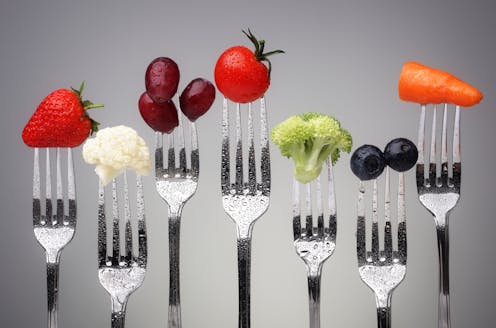
You’ve probably read the stories proclaiming that eating blueberries reduces your risk of dementia, or red wine is good for your heart, or coffee protects against type 2 diabetes – or, indeed, many of the other big health claims for a particular “superfood”. But what is the truth in these statements?
While we – a group of nutritional scientists – have been involved in this kind of research, we are not responsible for the headlines. Underneath those attention-grabbing stories, however, there is important and serious research that will help to keep us all happier and healthier.
We study parts of foods called bioactives that have an effect on health (either good or bad). Unlike vitamins and minerals, bioactives, such as certain fatty acids, fibre or flavanols (a group compounds found, for example, in tea or apples), are not essential for survival, but still affect our health.
The big challenge with research on bioactives is to separate the effect of a food from an individual compound (foods are incredibly complex and contain many compounds). In a cup of coffee are some phenolic acids that have a positive effect on heart health, but other compounds that can increase cholesterol. This makes our research difficult – but also exciting.
We must find ways to distinguish between the health effect of different parts of foods to understand what is happening and ultimately provide more confidence in the recommendations we provide.
One way to find out more about the effect of individual foods on health is to compare people with different diets and follow them over a long time. That approach has helped us to show that the Mediterranean diet – and the Nordic diet – keep us healthier for longer. But this approach is flawed when we want to find out more about individual foods or their components.

Foods are never consumed in isolation and it is incredibly difficult to take this apart in such studies. To make the results of such research easier to understand, these findings are often converted into food equivalents – the infamous punnet of raspberries, cups of tea or bottles of wine you should consume for health. In reality, it is much more difficult.
Research into diet and health is difficult because there are many things to consider. There are the essential nutrients that we need to survive. There are dietary patterns that can affect overall health and that are the basis for recommendations, such as the UK government’s Eatwell guide. And then there are bioactive compounds that are found mainly in plant foods and that may have a beneficial effect on health.
Research into bioactives often results in headlines about amazing foods. In reality, it is just a tiny part of the food, often found elsewhere as well. A notable example is blueberries. They contain bioactives, but they are also expensive. Blackberries and plums provide the same bioactives, but are much cheaper.
Over the past decades, we have learned a lot about the chemicals naturally occurring in foods – what they are and how they affect the body. Some of them confer benefits for our heart, brain and gut that will help us sprint faster, cycle longer, concentrate harder and relax more easily.
Focus on variety
Many of them cause problems when consumed in excessive amounts though. For example green tea flavanols can cause liver damage when consumed in very large amounts. We are only just starting to find out whether there is an ideal amount of these compounds that provide maximum benefits. Until then, it is safe to say that a varied diet is the best approach.
The great thing about our understanding of nutrition is that it is continuously evolving and improving and we understand much better what foods to look out for as research moves on.
Everyone should build up a sort of portfolio of diet that includes the essential nutrients, fibre and bioactives needed to keep healthy and age well. Our bodies are incredibly complex and need lots of different vitamins, minerals, macro and micronutrients to optimally keep us going. It now seems likely that we need to add bioactives to this list. But it doesn’t matter where they are coming from – it is variety that is important.
You should be wary about dietary advice that suggests you exclude the range of wonderful foods on offer and focus on a few “superfoods” that seemingly have magical properties. Nutrition is much more complex than that – and eating a healthy diet is much easier.
Gunter Kuhnle has received funding from Mars, Inc., for research into flavan-3-ols.
Charlotte Mills receives funding from UKRI to research bioactive levels in plant foods and their impact on health.
Jeremy Spencer receives funding from the UK research councils, three of which have been part of the BBSRCs Industrial Partnership Award scheme, which encourages interaction with industry.
This article was originally published on The Conversation. Read the original article.







